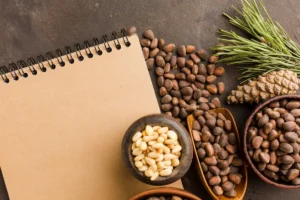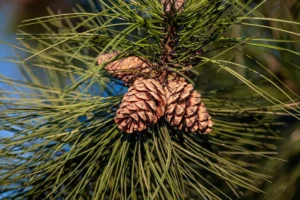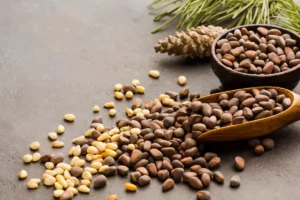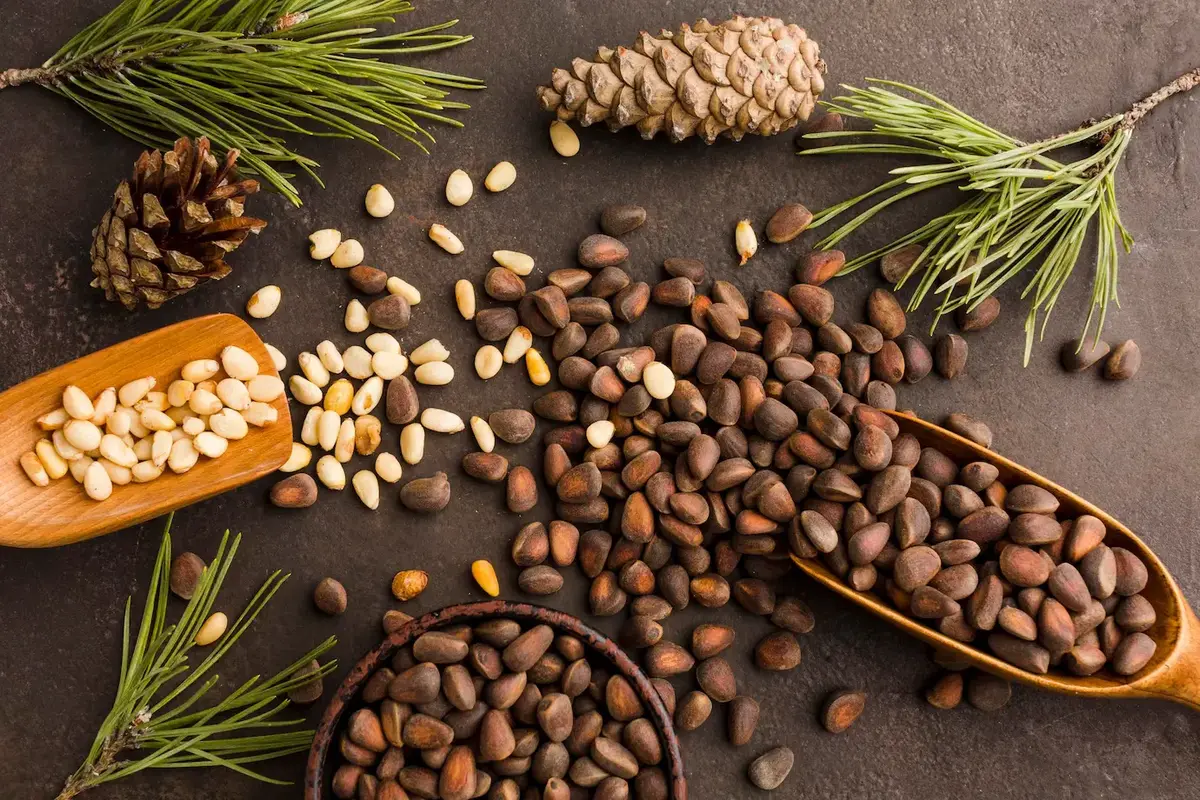In a world brimming with culinary delights, the humble pine nut and pignoli nut have carved out a special place in kitchens far and wide. These tiny treasures, though small in size, pack a punch of flavor and versatility that’s hard to beat. Whether you’re whipping up a batch of pesto or sprinkling them over a salad, the question often arises: are pine nuts and pignoli the same? This article delves into the heart of this query, exploring the origins, culinary uses, and fascinating facts about these beloved nuts. So, buckle up and get ready to embark on a nutty adventure that promises to enlighten and entertain.
Introduction
Understanding Pine Nuts and Pignoli: An Overview
Dive into the world of pine nuts and pignoli, and you’ll discover a tale as rich and savory as the nuts themselves. Often, we come across these terms, especially in recipes calling for that distinct, nutty flavor. But, let’s face it, confusion abounds. Are they twin culinary stars under different names, or is there more to the story?
Well, folks, the short answer is a resounding “Yes!” Pine nuts and pignoli are indeed the same delightful ingredient, known by different names across the globe. However, don’t dash off just yet! There’s a whole saga behind these nuts that’s as intriguing as it is appetizing.
The Question at Hand: Are They the Same?
At first glance, one might think that pine nuts and pignoli hail from different corners of the culinary universe. After all, “pignoli” does have a rather exotic ring to it, doesn’t it? But, as fate would have it, they’re two peas in a pod—or should we say, two nuts in a cone? That’s right, both names refer to the seeds of pine cones, harvested from the whispering pine trees that grace our landscapes.
A Cultural and Culinary Staple
Now, before you go nuts over pine nuts, let’s take a moment to appreciate their journey from pine cone to plate. These seeds have been a staple in Mediterranean cuisine for centuries, lending their sweet, buttery flavor to dishes that have become beloved by many. From the sunny coasts of Italy to the rugged landscapes of the American Southwest, pine nuts have found their way into an array of recipes that span cultures and continents.
But, why the name “pignoli,” you ask? Well, it’s all thanks to our Italian friends. In Italy, where these nuts are particularly cherished, “pignoli” is the term of choice. It’s a nod to their cherished place in Italian cooking, from pesto genovese to those irresistible pignoli cookies that have a knack for disappearing from the cookie jar.
So, as we peel back the layers of this nutty mystery, we find that pine nuts and pignoli are indeed one and the same. But, oh, there’s so much more to learn about these tiny yet mighty culinary heroes. Stick around as we crack open the world of pine nuts and pignoli, exploring their cultivation, culinary uses, and the peculiar phenomenon known as “pine nut syndrome.” It’s a journey you won’t want to miss, sprinkled with tips, trivia, and, of course, a dash of nutty humor.
The Basics

What are Pine Nuts and Pignoli Nuts?
Diving deeper into our nutty narrative, let’s get to the kernel of what pine nuts and pignoli nuts truly are. These little gems are the edible seeds of pine trees, yes, the same ones that grace our landscapes with their majestic presence. Not all pine trees, mind you, but specifically those belonging to the Pinus genus, which have the honor of producing the seeds we so love.
Definitions and Origins
A pine nut, or pignoli, is not just any seed; it’s a testament to nature’s patience and generosity. These seeds are harvested from pine cones—nature’s own treasure chests—after a gestation period that can last from 18 months to three years. Imagine waiting that long for your next meal! Originating from various regions, including the Mediterranean, Asia, and North America, these nuts have traversed continents and cuisines, making themselves indispensable in many a recipe.
Pine Nuts in Global Cuisine
Now, onto the culinary stage they go! Pine nuts have a starring role in an array of dishes worldwide. Their subtle sweetness and buttery texture make them a versatile ingredient, from the creamy swirls of pesto to the crunchy topping on a salad. In Italian cuisine, pignoli are the secret behind the rich flavor of traditional pesto, while in Middle Eastern dishes, they add a delicate crunch to meat and rice preparations.
But it’s not just about taste; these nuts are also a powerhouse of nutrition. Rich in vitamins, minerals, and heart-healthy fats, they’re a splendid addition to any diet, bringing both flavor and health benefits to the table. So, whether you’re sprinkling them over a dish or blending them into a sauce, remember, you’re not just adding a nut; you’re adding a nugget of history and health.
As we move from the basics to the branches, it’s clear that pine nuts and pignoli are much more than just ingredients. They’re culinary bridges connecting traditions, cultures, and flavors across the globe. So, the next time you hold one of these precious seeds in your hand, take a moment to appreciate its journey from the towering pine to your plate. Stay tuned as we delve into the fascinating process of how these nuts are brought to our kitchens in the next section of our nutty adventure.
Cultivation and Harvesting

The Journey from Pine Cone to Nut
Embarking further into our exploration, let’s uncover the intricate process that transforms a humble pine cone into the culinary gold we know as pine nuts or pignoli. This journey, steeped in tradition and patience, is a testament to the labor of love invested in bringing these nuts to our tables.
Growth and Maturation of Pine Cones
First off, not all pine cones are created equal—at least, not when it comes to producing pine nuts. Only certain pine species have the honor of bearing the seeds we covet. These trees, which can live for decades, if not centuries, begin their magical process in the spring, when new cones form and start their slow dance towards maturity.
This isn’t a quick step; it’s more of a slow waltz. Depending on the species, pine cones can take anywhere from 18 months to three years to mature fully. Throughout this time, they’re at the mercy of the elements, undergoing seasons of growth and dormancy until they’re ready for harvest.
Harvesting Process and Challenges
Now, here’s where human tenacity comes into play. The harvesting of pine nuts is no small feat. It requires a keen eye, patience, and a gentle hand. Once the cones have matured, they’re carefully collected and then left to dry, often in burlap sacks under the sun, for about 20 days. This drying process encourages the cones to open up, revealing the seeds within.
But the journey doesn’t end there. Once the cones have opened, the seeds—or pine nuts, as we fondly call them—need to be extracted. This is often done by hand, a meticulous process that underscores the value and preciousness of these nuts. And let’s not forget the shell! Pine nuts come encased in a hard shell that must be removed before they can grace our dishes. Some varieties boast particularly tough shells, adding another layer of challenge to the process.
The laborious nature of harvesting and processing pine nuts contributes to their premium price. But as anyone who’s tasted them can attest, they’re worth every penny. Their unique flavor and nutritional profile make them a sought-after ingredient in kitchens worldwide.
So, the next time you enjoy a spoonful of pesto or savor a pignoli cookie, spare a thought for the incredible journey these nuts have made. From the towering pine trees to the meticulous hands that harvest and prepare them, it’s a journey of nature, nurture, and culinary tradition.
Stay tuned as we dive into the beloved culinary uses of pine nuts and pignoli, revealing why they remain indispensable in both traditional and modern kitchens.
Culinary Uses

Pignoli and Pine Nuts in Cooking
As we venture into the heart of our nutty tale, the culinary stage where pine nuts and pignoli shine the brightest beckons. These little kernels of joy are not just ingredients; they’re bridges to culinary heritage and innovation, sprinkling dishes with their unique blend of flavors and textures.
Traditional Recipes and Modern Adaptations
In the realm of traditional cooking, pine nuts hold a place of honor. From the shores of the Mediterranean to the bustling markets of the Middle East, these nuts have been lending their delicate, buttery flavor to dishes for centuries. In Italy, no pesto is complete without a generous helping of pignoli, ground into a fine paste with basil, Parmesan, garlic, and olive oil. This green sauce, a staple of Italian cuisine, owes its rich, nuanced flavor to the humble pine nut.
But the journey doesn’t end in Italy. In the Middle East, pine nuts are sprinkled over dishes like pilaf and kibbeh, adding a crunchy texture and a whisper of sweetness that elevates the meal. And let’s not forget about the world of baking, where pignoli cookies steal the show. These almond-based delights, encrusted with pine nuts, are a testament to the versatility and enduring appeal of this ingredient.
Modern cuisine, too, has embraced pine nuts with open arms, incorporating them into salads, pastas, and even smoothies for a touch of nutty goodness. Their ability to blend seamlessly into a variety of dishes while also standing out as a centerpiece ingredient is truly remarkable.
Health Benefits and Nutritional Value
Beyond their culinary prowess, pine nuts are also celebrated for their nutritional benefits. Packed with vitamins, minerals, and heart-healthy fats, they’re a powerhouse of nutrition. Rich in antioxidants, pine nuts can help combat oxidative stress and inflammation, making them a smart addition to any health-conscious diet.
Whether toasted to perfection and sprinkled over a fresh salad or ground into a smooth paste for a batch of homemade pesto, pine nuts and pignoli offer a world of culinary possibilities. Their subtle yet distinct flavor, combined with their nutritional profile, makes them a cherished ingredient in kitchens around the globe.
As we’ve journeyed from the forests where pine nuts are born to the kitchens where they’re transformed, it’s clear that these nuts are much more than just food. They’re a link to our past, a joy in our present, and a promise of culinary creativity for the future. Stay tuned as we explore the potential downsides of pine nuts, including the curious case of “pine nut syndrome,” in our next section.
Potential Downsides
Pine Nut Syndrome: A Taste Disturbance
As we’ve savored the rich tapestry of flavors and traditions that pine nuts and pignoli bring to our tables, it’s also important to acknowledge a peculiar phenomenon associated with these nuts. Known as “pine nut syndrome” or “pine mouth,” it’s a curious and somewhat baffling condition that can leave a bitter taste in one’s mouth—quite literally.
Symptoms and Causes
Pine nut syndrome is a temporary taste disturbance that some people experience after consuming pine nuts. Typically manifesting within 12 to 48 hours after eating, the condition is characterized by a metallic or bitter taste that can last for days or even up to two weeks. While it’s not harmful or dangerous, it can certainly put a damper on your dining experience, making even your favorite foods taste oddly unpleasant.
The exact cause of pine nut syndrome remains a bit of a mystery, though it’s believed to be linked to certain species of pine nuts. Research suggests that nuts harvested from particular types of pine trees, especially those imported from certain regions, may be more likely to trigger this taste disturbance.
How to Avoid Pine Nut Mouth
So, what can you do to avoid falling victim to this culinary curse? First and foremost, sourcing your pine nuts from reputable suppliers can help minimize the risk. Pay attention to the origin of the nuts, opting for those known to come from species less likely to cause issues. Additionally, keeping pine nuts fresh by storing them properly—cool, dark places or even the refrigerator—can also reduce the chances of pine nut syndrome.
While pine nut syndrome might sound like a reason to steer clear of these nuts, it’s worth noting that the condition is relatively rare. The vast majority of people enjoy pine nuts and pignoli without any adverse effects, reaping the benefits of their delightful taste and nutritional bounty.
As we’ve explored the enchanting world of pine nuts and pignoli, from their origins to their place in culinary history and even the potential pitfalls, it’s clear that these nuts hold a special place in the hearts and kitchens of many. As we wrap up our nutty journey, let’s look ahead to the conclusion, where we’ll reflect on the enduring allure of pine nuts and pignoli and their indispensable role in cooking and culture.
FAQs
Frequently Asked Questions
In our journey through the world of pine nuts and pignoli, we’ve uncovered their origins, culinary uses, and even the curious case of pine nut syndrome. Yet, as with any ingredient rich in history and flavor, questions abound. Here, we’ll tackle some of the most common inquiries, shedding light on these culinary gems.
Are pine nuts and pignoli nuts used differently in recipes?
Nope, they’re one and the same, so they can be used interchangeably in recipes. Whether your dish calls for pine nuts or pignoli, you’re adding the same nutty, buttery flavor that enhances everything from pesto to cookies.
Can eating pine nuts cause allergic reactions?
Yes, like other nuts, pine nuts can trigger allergic reactions in some individuals. If you have a tree nut allergy, it’s wise to approach pine nuts with caution and consult with a healthcare provider if you’re unsure about potential allergies.
How can I store pine nuts to extend their shelf life?
To keep pine nuts fresh and tasty, store them in an airtight container in a cool, dark place. For longer storage, you can refrigerate or even freeze them. Just make sure to bring them to room temperature before using them in your recipes to enjoy their full flavor.
Conclusion
Embracing the Versatility of Pine Nuts and Pignoli
As we conclude our exploration of pine nuts and pignoli, it’s clear these tiny treasures offer more than just a crunch to our dishes. They are a testament to nature’s bounty, a bridge between cultures, and a beloved ingredient that transcends culinary boundaries.
A Must-Have Ingredient for Diverse Recipes
The versatility of pine nuts is unparalleled, making them a staple in both traditional and contemporary cuisines. From the rich, green swirls of pesto to the sweet, almond-based dough of pignoli cookies, these nuts bring depth, nutrition, and a touch of luxury to our plates.
Final Thoughts on Pine Nuts and Pignoli
As we’ve journeyed from the towering pine forests to the heart of our kitchens, the story of pine nuts and pignoli has unfolded as one of culinary heritage, nutritional wealth, and enduring appeal. These nuts remind us that great flavors often come in small packages, and their continued popularity underscores our collective desire for ingredients that connect us to the natural world and to each other.
So, whether you’re a seasoned chef or a home cook looking to add a new twist to your meals, pine nuts offer a world of possibilities. They’re not just an ingredient; they’re a way to travel through taste, explore new culinary landscapes, and create dishes that speak to the heart of our shared culinary traditions.
Thank you for joining me on this nutty adventure. May your dishes be rich in flavor, your pine nuts always fresh, and your culinary explorations endlessly rewarding.

